Henry Stuart (1885-1942) was a British-Swiss actor, director and writer, who was very successful in the German silent cinema.
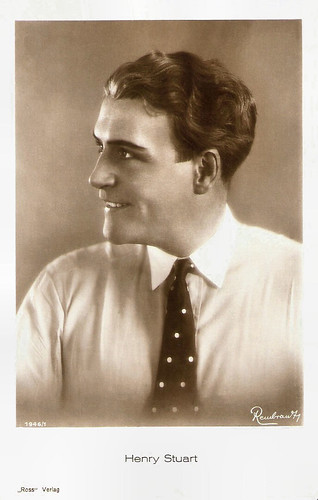
German postcard by Ross Verlag, no. 1946/1, 1927-1928. Photo: Rembrandt.
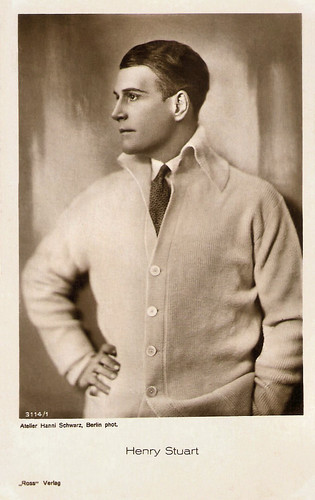
German postcard by Ross Verlag, no. 3114/1, 1928-1929. Photo: Atelier Hanni Schwarz, Berlin.
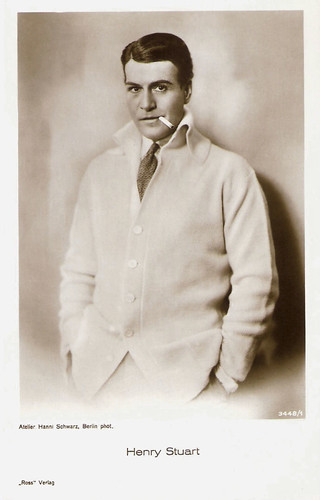
German postcard by Ross Verlag, no. 3448/1, 1928-1929. Photo: Atelier Hanni Schwarz.
Henry Stuart was born as Henry Eduard Hess in Cairo, Egypt, in 1885. He was the son of a British colonial employee. Shortly before 1900 he returned to Britain but grew up mostly in Paris.
He visited the Akademie der Bildenden Künste München (Academy of Fine Arts in Munich), planning to become a painter. Shortly before World War One broke out, he was in Vienna, where he established his first contacts in the film world. During the war Stuart stayed in Britain, but afterwards he returned to Germany.
In 1922 he started his highly successful career as actor in the German silent cinema, often performing the perfect gentleman and noble lover. Probably his first appearance was a small part in the elaborate costume drama Ein Glas Wasser/A Glass of Water (Ludwig Berger, 1922) set in England during the reign of Queen Anne (Mady Christians). According to Wikipedia, the film was very well received both commercially and critically on its release. The film, based on a play of the same title by Eugène Scribe, is considered one of the milestones of Weimar cinema.
It was followed by the fantasy Die Perrücke/The Wig (Berthold Viertel, 1924) in which he played the major part of Julian, the lover of the Princess (Jenny Hasselqvist), whose husband (Otto Gebühr) tries to separate them.
In another classic Die freudlose Gasse/Joyless Street (G.W. Pabst, 1925), a morality tale set during the Viennese Depression, Stuart plays Egon Stirner, the secretary of an international speculator. He is arrested for the murder of a lawyer’s wife, but the culprit is the penniless Maria Lechner (Asta Nielsen). Maria is desperately in love with Stirner and has murdered the woman because she suspected her to be a rival. The film which also features Greta Garbo in one of her first roles, was one of the first films of the 'New Objectivity' movement.
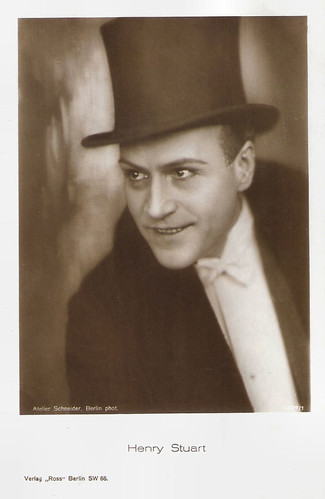
German postcard by Ross Verlag, Berlin, no. 1327/1, 1927-1928. Photo: Atelier Schneider, Berlin.
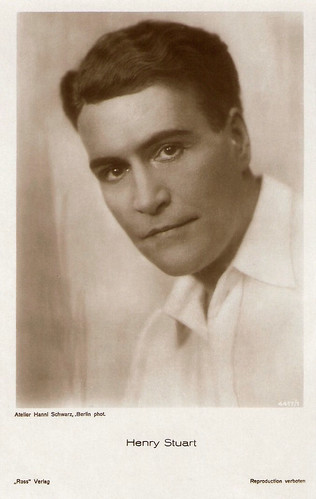
German postcard by Ross Verlag, no. 4417/1, 1929-1930. Photo: Atelier Hanni Schwarz, Berlin.
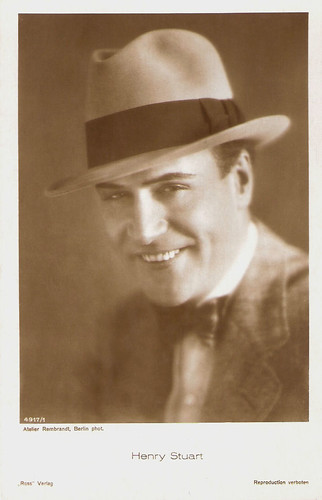
German postcard by Ross Verlag, no. 4917/1, 1929-1930. Photo: Atelier Rembrandt, Berlin.
In the following years Henry Suart starred in an impressive series of films. In 1925 he appeared in Die Strasse des Vergessens/The Street of Forgetting (Heinz Paul, 1925) with Hella Moja, and Das Abenteuer der Sybille Brant/The Adventures of Sybil Brent (Carl Froehlich, 1925) with Henny Porten.
The following year, he acted in such films as Unter Ausschluss der Öffentlichkeit/Under exclusion of the public (Conrad Wiene, 1926) with Maly Delschaft, Schenk mir das Leben/Give me the life (Klaus Fery, 1926), the war film Die versunkene Flotte/Wrath of the Seas (Graham Hewett, Manfred Noa, 1926) with Nils Asther, Die zwei und die Dame/The Two and the Lady (Alwin Neuss, 1926) with Agnes Esterhazy and Bernhard Goetzke, and Das Mädchen ohne Heimat/The Girl Without a Homeland (Constantin J. David, 1926).
In 1927 he appeared in Liebelei/Flirtation (Jakob & Luise Fleck, 1927) with Fred Louis Lerch and Evelyn Holt, Wenn Menschen reif zur Liebe werden/When people become ripe for love (Jakob & Luise Fleck, 1927), Die geheime Macht/Sajenko the Soviet (Erich Waschneck, 1927) with Walter Rilla, Die Frau mit dem Weltrekord/The Woman with the World Record (Erich Waschneck, 1927) with Lee Parry, and Der Bettler vom Kölner Dom/The beggar of the Cologne cathedral (Rolf Randolf, 1927) with Hanni Weisse.
He starred opposite Brigitte Helm in Der Skandal in Baden-Baden/The Scandal in Baden-Baden (Erich Waschneck, 1928). That same year, Stuart went to India to stage the feature film Der Ring der Bajadere, as well as direct the documentaries Der Maharadscha von Mysore hat Geburtstag/The Birthday of the Maharadja of Mysore (Henry Stuart, 1929) and Nuri, der Elefant/Nuri, the Elephant (Henry Stuart, 1930).
Back in Germany, Stuart played his last roles in silent films: the industrialist Erwin Voss in Das Recht auf Liebe/The right on love (Jakob & Luise Fleck, 1929), The film addresses the issue of the rights of ex-soldiers made impotent by war wounds to get married. It was made in the Weimar tradition of the Aufklärungsfilme (Enlightenment films).
He also played Kaiser Franz in the part-talkie Der Günstling von Schönbrunn/The Favourite of Schonbrunn (1929), starring Iván Petrovich and Lil Dagover. The historical film was directed by Erich Waschneck but Max Reichmann directed the sound sequences.
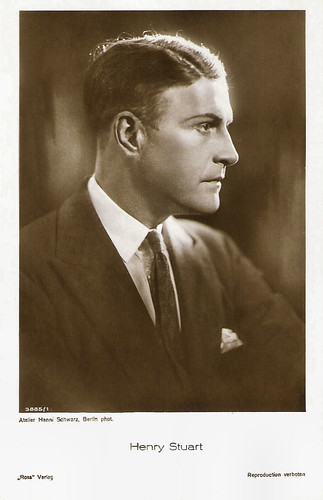
German postcard by Ross Verlag, no. 3885/1, 1928-1929. Photo: Atelier Hanni Schwarz, Berlin.
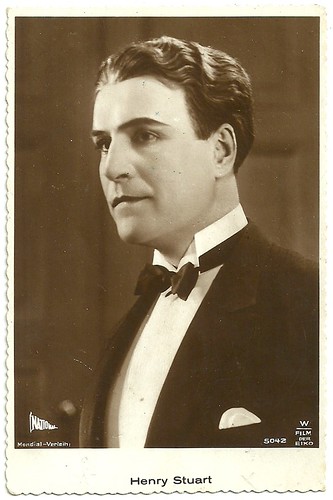
Austrian postcard, no. 5042. Photo: National / Mondial-Filmverleih / Eiko.
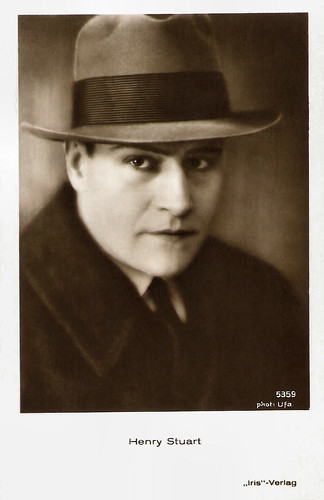
Austrian postcard by Iris Verlag, no. 5359. Photo: Ufa.
In the sound era, Henry Stuart didn’t find much work. In Berlin, he performed at the Englischen Theater Deutscher Schauspieler and worked for the radio as well as a manuscript and title translator. In 1933 he directed a short, Zwischen 12 und 2/Between 12 and 2, based on the play Hotelratten/Hotel rats.
In 1938 he co-wrote the script for the Yiddish-American production The Power of Life. He became Swiss citizen and in 1941 he released the only feature sound film directed by him: Krishna. Abenteuer im indischen Dschungel/Krishna, adventures in the Indian Jungle (1941), codirected and conscripted with Lola Kreuzberg, whose company had already produced Stuart’s films in India in 1928-1929. It probably was a sound version of Der Ring der Bajadere.
In 1942, Stuart played a British enemy in the propaganda film Germanin (Max W. Kimmich, 1942) starring famous Austrian mountain climber Luis Trenker as a German doctor in Africa who discovers and proves the efficacy of a cure for sleeping sickness - a serum called `Germanin'.
The film has strong anti-British undertones and the history of the film is horrendous. In the summer of 1940, 4,000 black POWs were transferred to Stalag IIIA, a Luckenwalde Germany Prisoner of War camp. Three hundred of these men, including African-Americans and French speaking Africans were forced to participate as extras in this Nazi film. Many of them were later exterminated by the Nazis.
His final film appearance was a small uncredited part, again as a British lord, in the all-star super-production Münchhausen/Baron Munchhausen (Josef von Baky, 1943) featuring Hans Albers. The Agfa colour epic was released after Stuart's death.
How, when and where exactly Henry Stuart died is unclear. His death year is indicated by several sources (IMDb, Cyranos, Filmportal.de) as 1942, but according to German Wikipedia it was after 1942. Another question is: did the Nazis force Stuart to appear in Germanin, like they had forced British silent film actor Jack Trevor to act in other anti-British propaganda films?
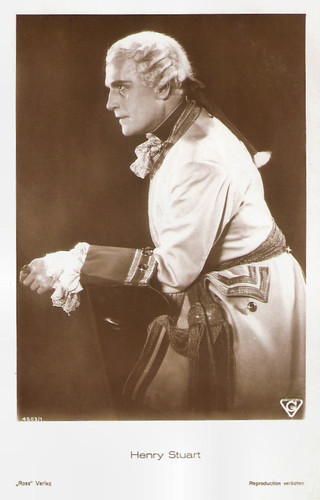
German postcard by Ross Verlag, no. 4503/1, 1929-1930. Photo: Photo: G [Greenbaum-Film]. Publicity still for Der Günstling von Schönbrunn/Favorite of Schonbrunn (Erich Waschneck, Max Reichmann, 1929).
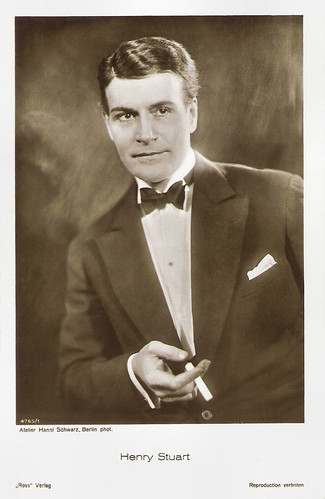
German postcard by Ross Verlag, no. 4765/1, 1929-1930. Photo: Photo: Atelier Hanni Schwarz, Berlin.
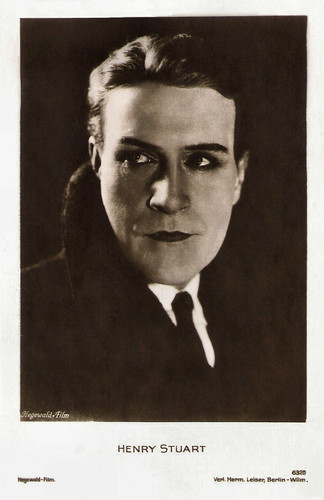
German postcard by Verlag Herm. Leiser, Berlin-Wilm., no. 6325. Photo: Hegewald-Film.
Sources: Filmportal.de, Thomas Staedeli (Cyranos), Wikipedia (English and German) and IMDb.

German postcard by Ross Verlag, no. 1946/1, 1927-1928. Photo: Rembrandt.

German postcard by Ross Verlag, no. 3114/1, 1928-1929. Photo: Atelier Hanni Schwarz, Berlin.

German postcard by Ross Verlag, no. 3448/1, 1928-1929. Photo: Atelier Hanni Schwarz.
Perfect Gentleman and Noble Lover
Henry Stuart was born as Henry Eduard Hess in Cairo, Egypt, in 1885. He was the son of a British colonial employee. Shortly before 1900 he returned to Britain but grew up mostly in Paris.
He visited the Akademie der Bildenden Künste München (Academy of Fine Arts in Munich), planning to become a painter. Shortly before World War One broke out, he was in Vienna, where he established his first contacts in the film world. During the war Stuart stayed in Britain, but afterwards he returned to Germany.
In 1922 he started his highly successful career as actor in the German silent cinema, often performing the perfect gentleman and noble lover. Probably his first appearance was a small part in the elaborate costume drama Ein Glas Wasser/A Glass of Water (Ludwig Berger, 1922) set in England during the reign of Queen Anne (Mady Christians). According to Wikipedia, the film was very well received both commercially and critically on its release. The film, based on a play of the same title by Eugène Scribe, is considered one of the milestones of Weimar cinema.
It was followed by the fantasy Die Perrücke/The Wig (Berthold Viertel, 1924) in which he played the major part of Julian, the lover of the Princess (Jenny Hasselqvist), whose husband (Otto Gebühr) tries to separate them.
In another classic Die freudlose Gasse/Joyless Street (G.W. Pabst, 1925), a morality tale set during the Viennese Depression, Stuart plays Egon Stirner, the secretary of an international speculator. He is arrested for the murder of a lawyer’s wife, but the culprit is the penniless Maria Lechner (Asta Nielsen). Maria is desperately in love with Stirner and has murdered the woman because she suspected her to be a rival. The film which also features Greta Garbo in one of her first roles, was one of the first films of the 'New Objectivity' movement.

German postcard by Ross Verlag, Berlin, no. 1327/1, 1927-1928. Photo: Atelier Schneider, Berlin.

German postcard by Ross Verlag, no. 4417/1, 1929-1930. Photo: Atelier Hanni Schwarz, Berlin.

German postcard by Ross Verlag, no. 4917/1, 1929-1930. Photo: Atelier Rembrandt, Berlin.
India
In the following years Henry Suart starred in an impressive series of films. In 1925 he appeared in Die Strasse des Vergessens/The Street of Forgetting (Heinz Paul, 1925) with Hella Moja, and Das Abenteuer der Sybille Brant/The Adventures of Sybil Brent (Carl Froehlich, 1925) with Henny Porten.
The following year, he acted in such films as Unter Ausschluss der Öffentlichkeit/Under exclusion of the public (Conrad Wiene, 1926) with Maly Delschaft, Schenk mir das Leben/Give me the life (Klaus Fery, 1926), the war film Die versunkene Flotte/Wrath of the Seas (Graham Hewett, Manfred Noa, 1926) with Nils Asther, Die zwei und die Dame/The Two and the Lady (Alwin Neuss, 1926) with Agnes Esterhazy and Bernhard Goetzke, and Das Mädchen ohne Heimat/The Girl Without a Homeland (Constantin J. David, 1926).
In 1927 he appeared in Liebelei/Flirtation (Jakob & Luise Fleck, 1927) with Fred Louis Lerch and Evelyn Holt, Wenn Menschen reif zur Liebe werden/When people become ripe for love (Jakob & Luise Fleck, 1927), Die geheime Macht/Sajenko the Soviet (Erich Waschneck, 1927) with Walter Rilla, Die Frau mit dem Weltrekord/The Woman with the World Record (Erich Waschneck, 1927) with Lee Parry, and Der Bettler vom Kölner Dom/The beggar of the Cologne cathedral (Rolf Randolf, 1927) with Hanni Weisse.
He starred opposite Brigitte Helm in Der Skandal in Baden-Baden/The Scandal in Baden-Baden (Erich Waschneck, 1928). That same year, Stuart went to India to stage the feature film Der Ring der Bajadere, as well as direct the documentaries Der Maharadscha von Mysore hat Geburtstag/The Birthday of the Maharadja of Mysore (Henry Stuart, 1929) and Nuri, der Elefant/Nuri, the Elephant (Henry Stuart, 1930).
Back in Germany, Stuart played his last roles in silent films: the industrialist Erwin Voss in Das Recht auf Liebe/The right on love (Jakob & Luise Fleck, 1929), The film addresses the issue of the rights of ex-soldiers made impotent by war wounds to get married. It was made in the Weimar tradition of the Aufklärungsfilme (Enlightenment films).
He also played Kaiser Franz in the part-talkie Der Günstling von Schönbrunn/The Favourite of Schonbrunn (1929), starring Iván Petrovich and Lil Dagover. The historical film was directed by Erich Waschneck but Max Reichmann directed the sound sequences.

German postcard by Ross Verlag, no. 3885/1, 1928-1929. Photo: Atelier Hanni Schwarz, Berlin.

Austrian postcard, no. 5042. Photo: National / Mondial-Filmverleih / Eiko.

Austrian postcard by Iris Verlag, no. 5359. Photo: Ufa.
All-Star Super-Production
In the sound era, Henry Stuart didn’t find much work. In Berlin, he performed at the Englischen Theater Deutscher Schauspieler and worked for the radio as well as a manuscript and title translator. In 1933 he directed a short, Zwischen 12 und 2/Between 12 and 2, based on the play Hotelratten/Hotel rats.
In 1938 he co-wrote the script for the Yiddish-American production The Power of Life. He became Swiss citizen and in 1941 he released the only feature sound film directed by him: Krishna. Abenteuer im indischen Dschungel/Krishna, adventures in the Indian Jungle (1941), codirected and conscripted with Lola Kreuzberg, whose company had already produced Stuart’s films in India in 1928-1929. It probably was a sound version of Der Ring der Bajadere.
In 1942, Stuart played a British enemy in the propaganda film Germanin (Max W. Kimmich, 1942) starring famous Austrian mountain climber Luis Trenker as a German doctor in Africa who discovers and proves the efficacy of a cure for sleeping sickness - a serum called `Germanin'.
The film has strong anti-British undertones and the history of the film is horrendous. In the summer of 1940, 4,000 black POWs were transferred to Stalag IIIA, a Luckenwalde Germany Prisoner of War camp. Three hundred of these men, including African-Americans and French speaking Africans were forced to participate as extras in this Nazi film. Many of them were later exterminated by the Nazis.
His final film appearance was a small uncredited part, again as a British lord, in the all-star super-production Münchhausen/Baron Munchhausen (Josef von Baky, 1943) featuring Hans Albers. The Agfa colour epic was released after Stuart's death.
How, when and where exactly Henry Stuart died is unclear. His death year is indicated by several sources (IMDb, Cyranos, Filmportal.de) as 1942, but according to German Wikipedia it was after 1942. Another question is: did the Nazis force Stuart to appear in Germanin, like they had forced British silent film actor Jack Trevor to act in other anti-British propaganda films?

German postcard by Ross Verlag, no. 4503/1, 1929-1930. Photo: Photo: G [Greenbaum-Film]. Publicity still for Der Günstling von Schönbrunn/Favorite of Schonbrunn (Erich Waschneck, Max Reichmann, 1929).

German postcard by Ross Verlag, no. 4765/1, 1929-1930. Photo: Photo: Atelier Hanni Schwarz, Berlin.

German postcard by Verlag Herm. Leiser, Berlin-Wilm., no. 6325. Photo: Hegewald-Film.
Sources: Filmportal.de, Thomas Staedeli (Cyranos), Wikipedia (English and German) and IMDb.
No comments:
Post a Comment